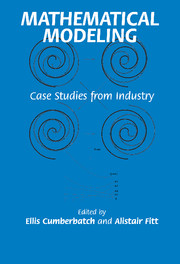Book contents
- Frontmatter
- Contents
- Contributors
- Preface
- Introduction
- 0 Mathematical Preliminaries
- 1 Fluid-Mechanical Modelling of the Scroll Compressor
- 2 Determining the Viscosity of a Carbon Paste Used in Smelting
- 3 The Vibrating Element Densitometer
- 4 Acoustic Emission from Damaged FRP-Hoop-Wrapped Cylinders
- 5 Modelling the Cooking of a Single Cereal Grain
- 6 Epidemic Waves in Animal Populations: A Case Study
- 7 Dynamics of Automotive Catalytic Converters
- 8 Analysis of an Endothermic Reaction in a Packed Column
- 9 Simulation of the Temperature Behaviour of Hot Glass during Cooling
- 10 Water Equilibration in Vapor-Diffusion Crystal Growth
- 11 Modelling of Quasi-Static and Dynamic Load Responses of Filled Viscoelastic Materials
- 12 A Gasdynamic–Acoustic Model of a Bird Scare Gun
- 13 Paper Tension Variations in a Printing Press
- Index
11 - Modelling of Quasi-Static and Dynamic Load Responses of Filled Viscoelastic Materials
Published online by Cambridge University Press: 05 June 2012
- Frontmatter
- Contents
- Contributors
- Preface
- Introduction
- 0 Mathematical Preliminaries
- 1 Fluid-Mechanical Modelling of the Scroll Compressor
- 2 Determining the Viscosity of a Carbon Paste Used in Smelting
- 3 The Vibrating Element Densitometer
- 4 Acoustic Emission from Damaged FRP-Hoop-Wrapped Cylinders
- 5 Modelling the Cooking of a Single Cereal Grain
- 6 Epidemic Waves in Animal Populations: A Case Study
- 7 Dynamics of Automotive Catalytic Converters
- 8 Analysis of an Endothermic Reaction in a Packed Column
- 9 Simulation of the Temperature Behaviour of Hot Glass during Cooling
- 10 Water Equilibration in Vapor-Diffusion Crystal Growth
- 11 Modelling of Quasi-Static and Dynamic Load Responses of Filled Viscoelastic Materials
- 12 A Gasdynamic–Acoustic Model of a Bird Scare Gun
- 13 Paper Tension Variations in a Printing Press
- Index
Summary
Introduction
The engineering uses of rubber have expanded well beyond traditional products such as tires and seals. Today elastomeric, or rubber-like, components can be found in a diverse set of constructs including engine mounts, building foundations, belts, and fenders (see [13], [22]). Increasingly, the applications of rubber are becoming more sophisticated, as exemplified by the use of rubber bearings in bridges which allow for thermal expansions of the deck without placing excessive loads on the bridge supports (see [15]).
In current engineering applications, elastomer composites are typically filled with inactive particles such as carbon black or silica. If active fillers were used, such as piezoelectric, magnetic, or conductive particles, the resulting controllable elastomer could be used in products such as active or smart vibration suppression devices (e.g. see [8], [17], [18]). As these new materials are developed, the role of design will increase in both complexity and importance. In particular, the capability to predict the dynamic mechanical response of the components will become increasingly valuable.
The many desirable characteristics of rubber as a design component, which include the ability to undergo large elastic deformations and provide significant damping with near incompressibility, are also contributing factors to the complications arising in the process of formulating models. Damping is highly complex, and the strain history, rate of loading, environmental temperature, and amount and type of filler affect the mechanical response in a nontrivial manner. Additionally, many elastomers exhibit strong hysteresis characteristics similar to those found in shape-memory alloys and piezoceramic actuators. Hysteretic effects in an elastomer include a time-history-dependent stress–strain constitutive law.
Information
- Type
- Chapter
- Information
- Mathematical ModelingCase Studies from Industry, pp. 229 - 252Publisher: Cambridge University PressPrint publication year: 2001
